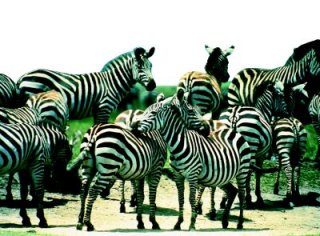
At the Omnimax
Africa: The Serengeti – opens October 16
"There is a place on Earth where it is still the morning of life, and
the great herds run free." So begins the new Omnimax Theater film,
which transports viewers on an East African safari.
This is your chance to see the world as it was before man encroached
on the wilds—a time when massive herds of two million hoofed animals roamed
vast plains all over the world.
Today, East Africa is the last remaining home of such herds, including
more than 1.5 million zebras, wildebeest, and gazelles. To escape the dry
season of their ancestral calving grounds, these animals make an annual
journey of 500 miles across the Serengeti Plains to the greener pastures
of Kenya’s Masai Mara Reserve. It is a dangerous trek. In addition
to grass fires, disease, and flood-gorged rivers, they are pursued by lions,
cheetahs, and crocodiles.
Directed by three-time Academy Award nominee George Casey and narrated
by James Earl Jones, the $3.6 million film is a tribute to the wildebeest
migration, and the land they occupy. This a land where archaeologists
have traced human life back two million years, where the indigenous Masai
people tend cattle and maintain their unique customs. Here, there
are spectacular sunsets, volcanic eruptions, and animals of all shapes
and colors, including elephants, hippos, monkeys, rhinos, flamingos, and
giraffe.
The sign at the entrance to the Serengeti National Park reads: "This
is the world as it was in the beginning." Try out this quiz
about life in the Serengeti, and then see the film to discover more fascinating
facts.
1) What unique belief do the Masai hold about cattle?
2) Tanzania is roughly the size of what American state?
3) What does "Serengeti" mean in Masai?
4) How many varieties of poisonous snake live on the Serengeti?
5) What do the Masai use animal urine for?
6) How many hours a day does an elephant eat?
7) How many neck bones does a giraffe have?
8) How many hours a day do lions sleep?
9) What is the top speed of a cheetah?
10) What is the most dangerous animal (in terms of natives killed)
on the Serengeti?
Click here for answers.
|

